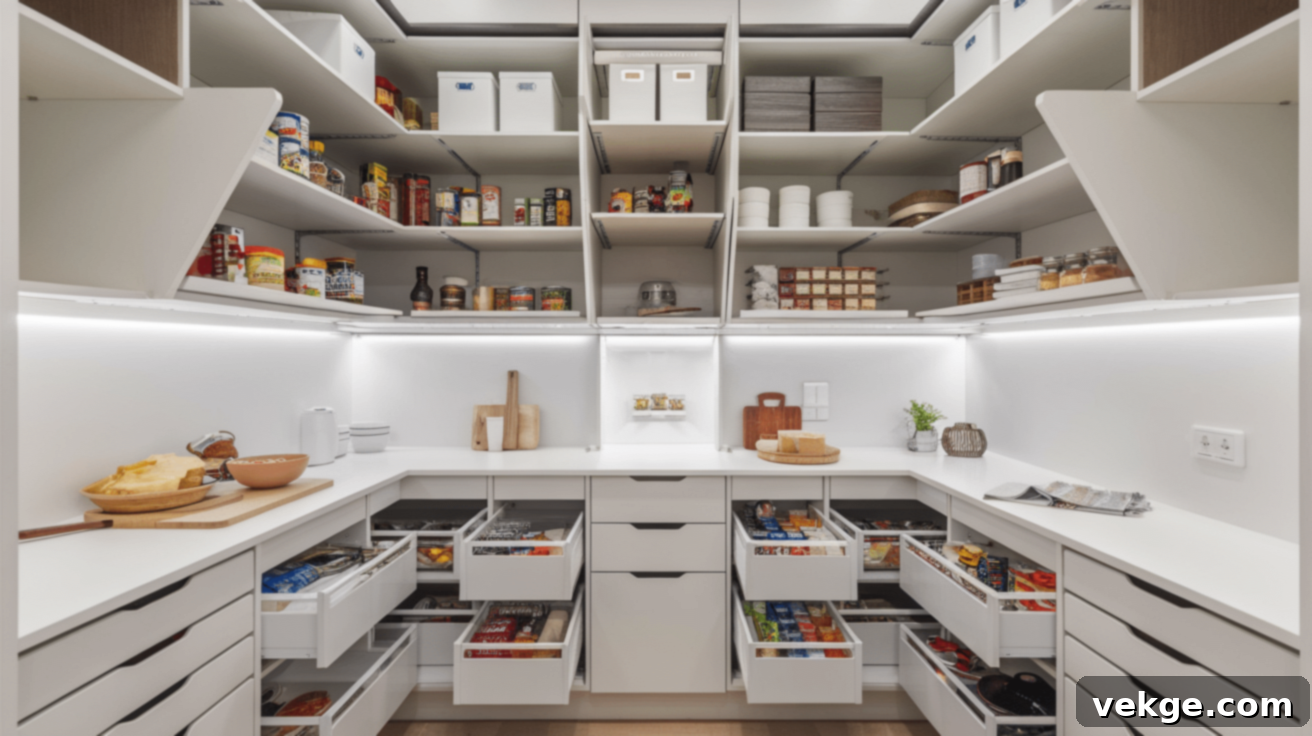Mastering Kitchen Organization: Your Guide to Designing the Perfect Pantry
The kitchen pantry is more than just a storage space; it’s the heart of an organized and efficient kitchen. A thoughtfully designed pantry can revolutionize your daily cooking experience, transforming chaotic meal preparations into calm and enjoyable sessions. Instead of scrambling to find ingredients, imagine everything neatly categorized and easily accessible, working seamlessly with your culinary flow.
With the right pantry setup, you’ll not only save precious time searching for items but also reduce food waste and streamline your grocery shopping. From basic, well-placed shelving to advanced, fully integrated organization systems, a good kitchen pantry keeps your essential ingredients within reach, maintains a clean and uncluttered kitchen aesthetic, and ultimately enhances the functionality of your entire home.
This comprehensive guide will explore practical options for various types of pantry cabinets, detail essential features to consider for optimal utility, and share smart strategies for planning your storage space. Our goal is to empower you to create a kitchen pantry that is not just useful, but also impeccably organized, and completely stress-free.
Understanding the Modern Kitchen Pantry
At its core, a pantry is a dedicated storage area within a kitchen specifically designed to organize and keep food, cooking ingredients, and sometimes additional kitchen supplies easily accessible. These specialized storage zones are fundamental in both residential homes and professional restaurant settings, providing a centralized location for storing non-perishable food items, canned goods, dry staples, baking supplies, and essential cooking ingredients.
A well-organized kitchen pantry transcends simple storage; it fundamentally transforms cooking experiences, making meal preparation more efficient, enjoyable, and less prone to last-minute scrambling. Homeowners frequently customize their pantry spaces, integrating a variety of shelving, specialized containers, and innovative organizational systems to maximize every inch of storage potential and ensure ingredients remain neatly arranged and easy to locate. Whether it’s a small cupboard or a dedicated room, a pantry is truly an essential component of any functional kitchen, holding everything from your daily spices and baking essentials to emergency food reserves.
Exploring Diverse Pantry Cabinet Styles
Selecting the ideal pantry type for your home hinges on several factors, including your kitchen’s overall size, your specific storage requirements, and your typical cooking habits. Each distinct pantry style offers unique benefits, allowing you to tailor your storage solution to create a truly functional and aesthetically pleasing kitchen environment.
1. Walk-in Pantries: The Ultimate Storage Solution
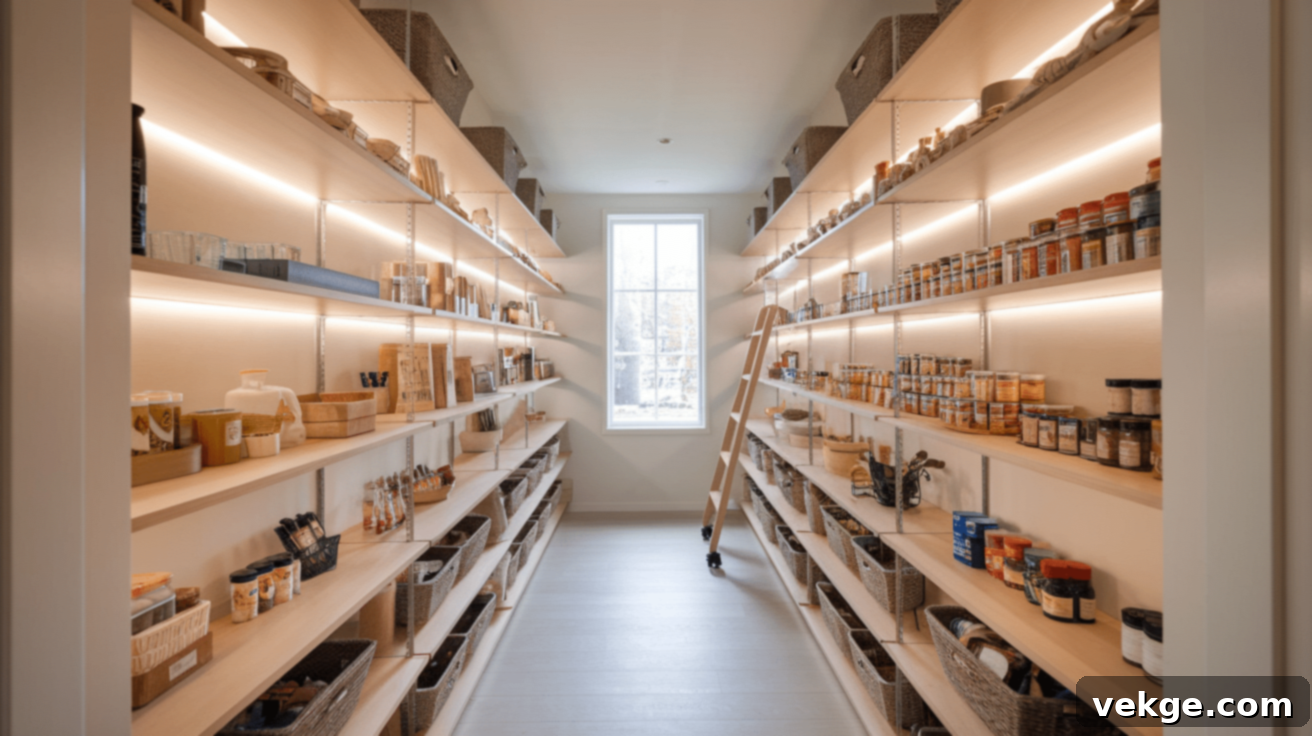
Walk-in pantries represent the pinnacle of generous storage, offering ample room to step inside and survey all your stored items at a glance. They are ideally suited for larger kitchens or homes where the floor plan comfortably accommodates a separate, room-like storage area. These spacious pantries are perfect for storing bulk items purchased at wholesale clubs, housing small kitchen appliances like stand mixers or slow cookers, and even allowing for the creation of distinct zones for different food categories (e.g., baking, breakfast, snacks).
The deep shelving characteristic of walk-in pantries provides abundant space for oversized containers, seasonal kitchenware, and less frequently used items that might not fit in standard cabinets. Many homeowners choose to install interior lighting fixtures, such as motion-activated LEDs, to significantly improve visibility when searching for ingredients. Furthermore, the walls can be outfitted with versatile hanging systems for items like brooms, aprons, reusable shopping bags, and other kitchen tools. With meticulous planning, a walk-in pantry can evolve beyond mere storage, becoming an extension of your kitchen workspace, offering additional counter space for food preparation or a dedicated station for small appliance use, thus greatly enhancing your kitchen’s overall utility.
2. Pull-out Pantries: Maximizing Narrow Spaces
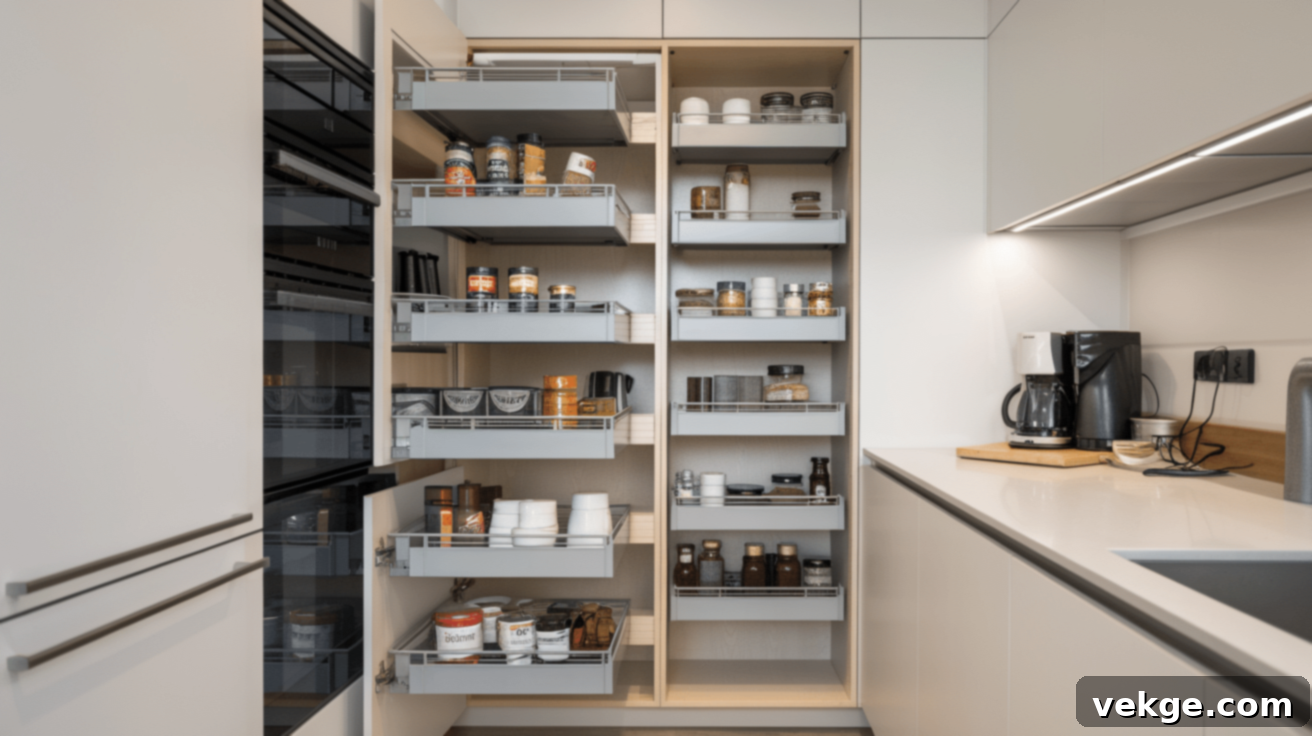
For those navigating the constraints of a smaller kitchen, pull-out pantries are an ingenious solution, making exceptional use of otherwise wasted narrow spaces. These innovative vertical storage units are designed to slide out smoothly and fully, bringing all their contents into clear view with a single, effortless motion. They fit perfectly between existing cabinetry, transforming slim, often overlooked gaps into highly functional storage for your kitchen essentials.
The slender design of pull-out pantries makes them ideal for neatly storing canned goods, spice jars, bottles of oil and vinegar, and other narrow items in an incredibly accessible manner. Many models boast adjustable shelving heights, allowing you to customize the interior to accommodate items of various sizes, from tall bottles to small condiment jars. The sophisticated sliding mechanisms typically incorporate soft-close features, preventing abrupt slamming and extending the lifespan of your pantry cabinets. Moreover, pull-out pantries are considerably easier to clean than deep, fixed cabinets, as you can fully access all areas without uncomfortable stretching or bending, ensuring a hygienic and well-maintained storage space.
3. Corner Pantries: Unlocking Hidden Potential
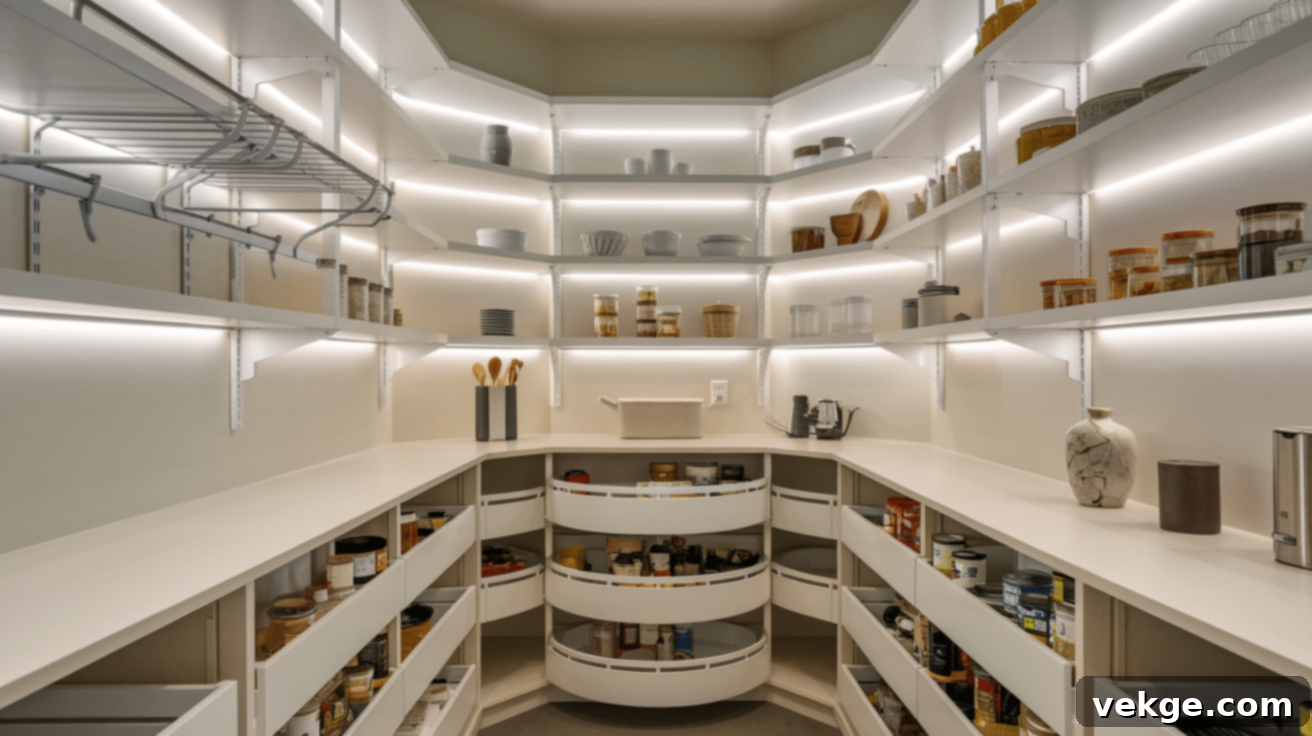
Corner spaces are notoriously underutilized in many kitchens, often becoming dead zones. A corner pantry, however, expertly transforms these awkward areas into invaluable storage real estate. When planning a corner pantry, it’s crucial to carefully consider how the doors will open and ensure that items stored in the deepest recesses remain easily reachable. Integrating angled shelving, for instance, can significantly improve accessibility to back areas and prevent items from being pushed out of sight.
Some corner pantry designs benefit immensely from pocket doors that slide discreetly away rather than swinging open, further conserving precious kitchen floor space. Custom interior inserts, such as diagonal bins, kidney-shaped rotating shelves (often called “Lazy Susans”), or pull-out systems, are excellent solutions for overcoming the common challenge of hard-to-reach corners. For maximum visibility and ease of access, especially in deeper sections of the pantry, consider adding small, energy-efficient LED lighting strips. These illuminate every corner, making it effortless to locate even the smallest items, ensuring no ingredient gets lost or forgotten.
Essential Features for an Optimal Pantry
Beyond the basic structure, certain features elevate a pantry from a simple storage unit to a highly efficient and enjoyable organizational hub. Thoughtful integration of these elements can significantly improve accessibility, freshness, and overall usability.
Shelves and Racks: The Backbone of Pantry Organization
The choice of shelving material and design profoundly impacts your pantry’s functionality and durability. Each material offers distinct advantages: robust wood shelving provides excellent stability for heavier items like large bags of flour or stacks of dinnerware; durable metal shelving offers strong support and a sleek, modern look; while wire shelving promotes superior air circulation, which is beneficial for certain food items and helps reduce dust buildup, simultaneously offering great visibility of all stored contents. Crucially, match your shelf depth and spacing to both your pantry’s overall dimensions and the specific items you intend to store. Varying depths can accommodate different package sizes, while adjustable spacing ensures flexibility for future needs.
Lazy Susans and Drawers: Enhancing Accessibility
Rotating lazy Susans are indispensable for making items in deep corner cabinets or the back of shelves effortlessly accessible. A simple spin brings everything into view, eliminating the need to rummage. Drawers, on the other hand, provide clear visibility and work exceptionally well for smaller, easily lost items such as spice packets, baking extracts, or small kitchen gadgets. Both options are masters at maximizing your storage space, effectively utilizing every inch, including those notorious hard-to-reach spots, ensuring a clutter-free and highly functional pantry.
Adjustable Shelving: The Epitome of Flexibility
Flexibility is paramount in effective pantry design. Adjustable shelving systems empower you to modify your storage space as your needs evolve over time, accommodating new groceries, seasonal items, or changing dietary habits. Look for shelving systems that offer a wide range of height options. This allows you to create the perfect custom fit for everything from tall cereal boxes and large olive oil bottles to small spice jars and delicate tea boxes, ensuring optimal space utilization and preventing wasted vertical space. This adaptability ensures your pantry remains efficient and organized for years to come.
Strategic Planning for Maximum Pantry Efficiency
To ensure your pantry is not just functional but truly effective, focus on implementing intelligent organizational strategies. This involves creating distinct zones for different food types and prioritizing accessibility for frequently used items.
Smart Storage Solutions: Creating Order from Chaos
Implementing a robust organization system is key to a truly functional pantry. Consider investing in clear, airtight containers with easy-to-read labels for bulk items like pasta, rice, flour, and sugar; this not only keeps ingredients fresh longer but also makes it simple to spot when supplies are running low. Group related items together—all baking supplies in one area, snacks in another, and breakfast items within easy reach. Multi-purpose bins and baskets are excellent for containing smaller packages, snack bags, or oddly shaped items, preventing them from scattering across shelves. A thoughtfully designed system significantly saves time during cooking, simplifies the restocking process, and ensures a consistently tidy pantry.
Maximizing Small Spaces: Ingenious Solutions for Compact Kitchens
Even the most compact kitchens can incorporate surprisingly effective pantry storage with clever design. The key is to think vertically: utilize tall, narrow cabinets that extend to the ceiling to capitalize on vertical space. Door-mounted racks are perfect for storing spices, small jars, foil, or plastic wrap, freeing up valuable shelf space. In particularly tight spots, innovative pull-out systems are invaluable, bringing contents forward for effortless access without requiring deep reach. Other solutions include installing shallow shelves in unusual nooks, using stackable containers, or adding pegboards to cabinet interiors for hanging utensils and small items, transforming every available surface into usable storage.
Installation and Maintenance for Lasting Pantry Performance
Proper installation and consistent maintenance are crucial for ensuring your pantry remains a functional and attractive asset to your kitchen for years to come.
DIY vs. Professional Installation: Weighing Your Options
While professional installation guarantees precision, structural integrity, and often a custom finish, a basic pantry system can be a rewarding and manageable DIY project for homeowners with some handy skills. If you opt for self-installation, meticulous planning is paramount: carefully measure your space multiple times, check for level surfaces, and securely fasten all components to wall studs or existing cabinetry for safety and stability. Using the correct tools is essential; ensure you have a stud finder, a level, a drill, and a screwdriver readily available before you begin. For heavier shelving units or large cabinet boxes, consider enlisting the help of a friend for an extra set of hands. Beginners might find it easier to start with simpler, modular systems rather than custom builds that demand advanced carpentry skills. Always plan your installation sequence methodically—typically, install bottom pieces first and then work your way up for the most stable results. Crucially, always read and fully understand the manufacturer’s instructions, as specific products may have unique installation requirements and safety guidelines.
Pantry Maintenance: Keeping Your Kitchen Hub Pristine
Regular and proactive cleaning is the secret to keeping your pantry fresh, functional, and inviting. Establish a consistent schedule—perhaps monthly—to check expiration dates, wipe down shelves, and reassess your organization system. Small, routine adjustments can prevent the need for more extensive, time-consuming overhauls. Practice food rotation by bringing older products to the front (first-in, first-out method), which significantly reduces waste and saves money. Seasonally, perform a deep clean of your pantry: remove all items, thoroughly dust corners, vacuum the floor, and wipe down containers before returning everything. For most cleaning, gentle soap and water are sufficient, especially for wooden shelves to protect their finish, or a vinegar and water solution for tougher spots, avoiding harsh chemicals near food storage. In humid climates, consider adding moisture absorbers to prevent dry goods from clumping, spoiling prematurely, or developing mold. Finally, take a complete inventory before each shopping trip; this prevents buying duplicates, helps you utilize existing stock, and allows for more effective management of your household’s food supply.
Seamless Kitchen Design Integration
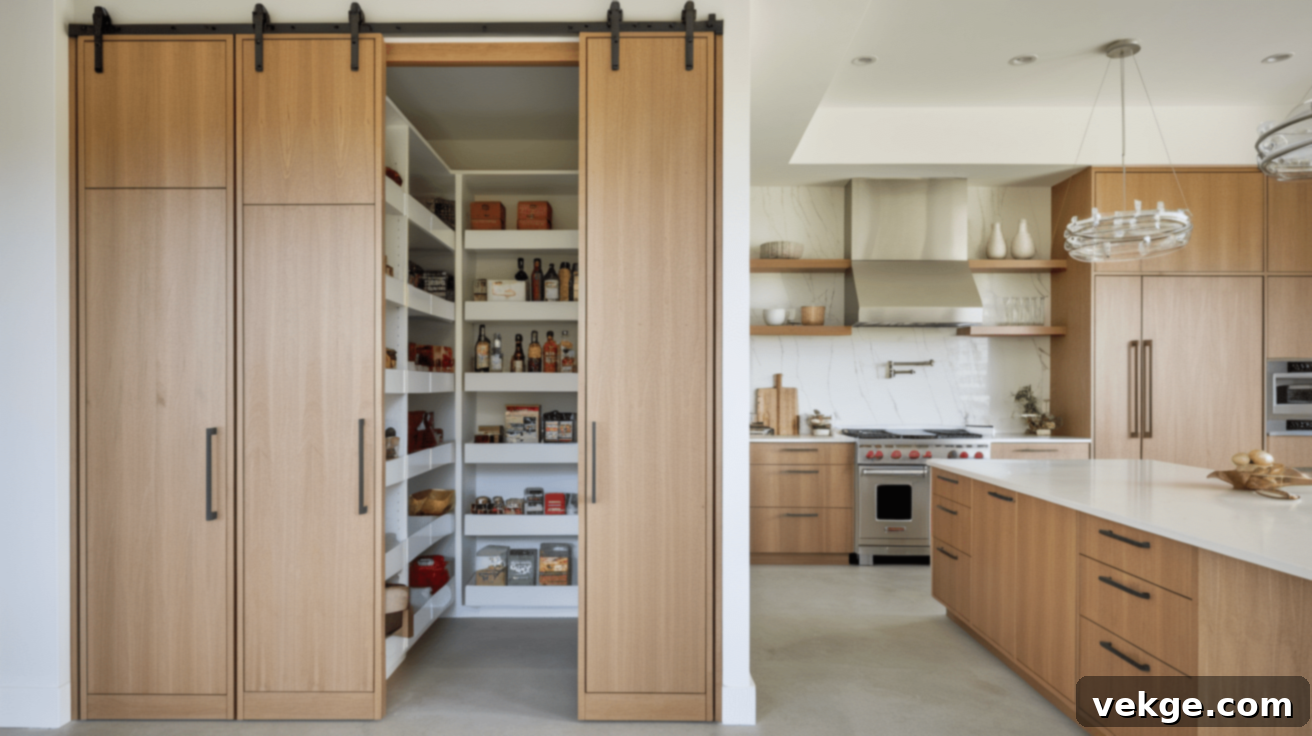
Your pantry should not stand in isolation; it should feel like a natural, harmonious extension of your entire kitchen. To achieve visual unity, select similar materials, hardware, and color palettes that complement your existing kitchen decor. If your pantry door is visible from other areas of the kitchen, carefully consider how its style aligns with your overall aesthetic—perhaps matching your main cabinet doors for a cohesive look, or offering a subtle, complementary contrast for visual interest.
For truly seamless integration, think deeply about the functional flow between your pantry and the rest of your kitchen workspace. Strategically position your pantry close to your primary food preparation areas, such as the countertops and stove. This minimizes the number of steps required when cooking, making ingredient retrieval incredibly efficient. This thoughtful placement is vital for creating a kitchen that functions optimally for daily use, reducing unnecessary movement and increasing convenience. Many homeowners discover that a pantry located in close proximity to the refrigerator creates a natural and highly efficient “food zone,” which significantly simplifies meal planning, grocery unloading, and long-term food storage.
Conclusion: Your Path to an Organized Kitchen Pantry
A thoughtfully designed and meticulously organized kitchen pantry is an invaluable asset that adds immense value to your home and dramatically enhances your daily life. The right pantry design delivers unparalleled organization, facilitates smoother meal preparation, and ultimately reduces stress during cooking, allowing you to enjoy your culinary endeavors more fully. Take a moment to reflect on what matters most in your daily routine: is it easy, immediate access to frequently used items? Ample space for bulk storage and long-term supplies? Or perhaps simple, visual ways to keep everything in sight and accounted for?
Your perfect pantry is a personalized solution that perfectly matches your specific kitchen layout, your household’s unique needs, and your individual cooking style. Begin with the foundational elements of good shelving and smart zoning, then thoughtfully incorporate specialized features like pull-out drawers, rotating lazy Susans, or custom bins that make the most sense for your available space and usage patterns. Remember that even the smallest kitchens can accommodate incredibly smart and effective pantry solutions with careful planning, creative thinking, and a focus on maximizing every inch. Are you ready to transform your kitchen and elevate your home organization? Take the first step today and start creating your ideal pantry—a space that will bring order, efficiency, and joy to your cooking for years to come.
